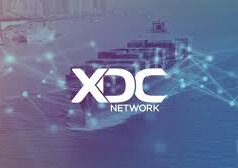July 10, 2025
The global trade finance industry, a cornerstone of the $30 trillion international trade market, is undergoing a seismic shift. Major banks, financial institutions, and governments are increasingly turning to blockchain technology to streamline processes, reduce inefficiencies, and enhance transparency. At the forefront of this transformation is the XDC Network, a hybrid blockchain platform revolutionizing digital documentation in trade finance. As blockchain adoption accelerates, XDC is positioning itself as a leader in this rapidly evolving landscape.
The Challenges of Traditional Trade Finance
Trade finance, which facilitates the exchange of goods and services across borders, has long relied on paper-based processes, manual documentation, and fragmented systems. Letters of credit, bills of lading, and invoices often pass through multiple intermediaries, leading to delays, high costs, and risks of fraud. According to the World Trade Organization, inefficiencies in trade finance add up to $1.5 trillion annually in operational costs, while the trade finance gap—unmet demand for financing—stands at $2.5 trillion, disproportionately affecting small and medium-sized enterprises (SMEs).
These challenges have pushed the industry to seek innovative solutions. Blockchain, with its decentralized, secure, and transparent ledger, offers a transformative approach to modernizing trade finance.
Blockchain: A Game-Changer for Trade Finance
Blockchain technology enables real-time, tamper-proof record-keeping, eliminating the need for intermediaries and reducing paperwork. By digitizing trade documents and automating processes through smart contracts, blockchain enhances efficiency, cuts costs, and mitigates risks. Major players in the financial sector are recognizing these benefits:
- HSBC has leveraged blockchain to process over $250 billion in trade transactions, reducing processing times by up to 50%.
- Standard Chartered partnered with blockchain platforms to digitize letters of credit, improving transparency for clients.
- Governments, such as Singapore and the UAE, are launching blockchain-based trade corridors to facilitate cross-border transactions.
The adoption of blockchain is not just a trend—it’s a strategic move to capture a slice of the $30 trillion global trade market while addressing long-standing inefficiencies.
XDC Network: Pioneering Digital Documentation
Among the blockchain platforms driving this revolution, the XDC Network stands out for its focus on trade finance and digital documentation. XDC, short for eXchange in Digital Commerce, is a hybrid blockchain combining the speed and scalability of public blockchains with the privacy and compliance features of private networks. Its unique architecture makes it an ideal fit for trade finance applications.
Why XDC Network?
- Digital Trade Documents: XDC Network enables the creation, transfer, and verification of digital trade documents, such as bills of lading and letters of credit, in a secure and immutable environment. This eliminates the risk of document fraud and accelerates transaction cycles.
- Interoperability: XDC’s hybrid design allows seamless integration with existing financial systems and other blockchains, ensuring compatibility with legacy infrastructure used by banks and corporates.
- Cost Efficiency: With transaction fees as low as $0.00001, XDC offers a cost-effective alternative to traditional systems, making it accessible for SMEs and large enterprises alike.
- Regulatory Compliance: XDC’s private subnets ensure compliance with regional regulations, such as KYC and AML, fostering trust among institutional users.
- Global Reach: XDC has forged partnerships with trade finance platforms like TradeFinex and institutions across Asia, Europe, and the Middle East, expanding its footprint in the global trade ecosystem.
Real-World Impact
The XDC Network is already making waves in trade finance. For instance, TradeFinex, built on XDC, has facilitated over $10 million in trade finance transactions for SMEs in emerging markets. By digitizing documents and automating workflows, XDC reduces processing times from weeks to hours, unlocking liquidity for businesses that struggle to access traditional financing.
In Singapore, a hub for global trade, XDC is collaborating with fintechs and logistics providers to create a blockchain-based trade corridor. This initiative aims to digitize end-to-end trade processes, from document issuance to payment settlement, setting a new standard for efficiency and transparency.
The Road Ahead for Blockchain in Trade Finance
As blockchain adoption accelerates, the trade finance industry is poised for unprecedented growth. The International Chamber of Commerce predicts that blockchain could reduce trade finance costs by 30% and close the $2.5 trillion trade finance gap by 2030. However, challenges remain, including regulatory hurdles, interoperability issues, and the need for widespread adoption among stakeholders.
XDC Network is well-positioned to address these challenges. Its focus on scalability, compliance, and partnerships with traditional financial institutions ensures it can bridge the gap between legacy systems and the decentralized future. As more banks and governments embrace blockchain, XDC’s role as a leader in digital documentation will only grow.
Conclusion
The global trade finance industry is at a turning point, and blockchain is the catalyst for change. With its ability to streamline processes, reduce costs, and enhance transparency, blockchain is reshaping how trade is conducted worldwide. The XDC Network, with its innovative approach to digital documentation, is leading this transformation, empowering businesses and institutions to thrive in the $30 trillion global trade market.
As we move toward a more connected and digitized world, XDC’s vision of frictionless trade finance is becoming a reality. For businesses, banks, and governments looking to stay ahead, embracing blockchain—and platforms like XDC—is no longer optional; it’s imperative.




























03rzlo